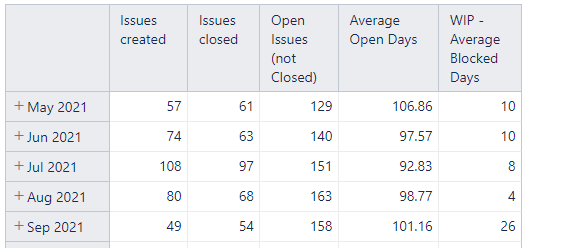We have a report that shows us some basic monthly stats including average open days as --average days open of not closed issues
Case WHEN [Measures].[Open Issues (not Closed)] > 0
THEN
Avg(
Filter(Descendants([Issue].CurrentMember, [Issue].[Issue]),
DateBeforePeriodEnd(
[Issue].CurrentMember.get(‘Created at’),
[Time].CurrentHierarchyMember) AND
NOT DateBeforePeriodEnd(
[Issue].CurrentMember.get(‘Closed at’),
[Time].CurrentHierarchyMember)
),
CASE WHEN
([Measures].[Issues created],
[Time].CurrentHierarchy.DefaultMember) > 0
THEN
CASE WHEN DateInPeriod(Now(), [Time].CurrentHierarchyMember)
THEN DateDiffDays([Issue].CurrentMember.get(‘Created at’),
Now())
ELSE DateDiffDays([Issue].CurrentMember.get(‘Created at’),
[Time].CurrentHierarchyMember.NextStartDate)
END
END
)
END
We would like to know for these issues what the average number of days the issue is not workable (Status = Blocked or Awaiting Information). My first pass has been to get an average for one of these so I can figure it out and I came up with:
Avg(
Filter(
Descendants([Issue].CurrentHierarchyMember,[Issue].[Issue]),
– filter with measure to pick issues based on dimension usage in the report and validation if issue has a transition from status In progress
([Measures].[Transitions to status],
[Transition Status].[Blocked])>0
AND
– filter by issue transition date from status In progress
DateInPeriod(
([Measures].[Transition to status first date],
[Transition Status].[Blocked],
[Time].CurrentHierarchy.DefaultMember),
[Time].CurrentHierarchyMember
)
),
– calculated time in days between first transition date to status In progress and first transition to status Done:
DateDiffDays(
([Measures].[Transition to status first date],
[Transition Status].[Blocked],
[Issue].CurrentHierarchy.DefaultMember),
([Measures].[Transition to status last date],
[Transition Status].[Blocked],
[Issue].CurrentHierarchy.DefaultMember)
)
)
The problem is that when this is used on a monthly report, it is reporting the average for the life of the issue, not just the average up until the reported month. I am also concerned that the denominator used for the average may be a different count for the 2 averages.
- by using Filter(Descendants([Issue].CurrentMember, [Issue].[Issue]), are they using the same count for the average?
- How can I get the query to understand prior periods? This is complicated as the issue may still be in the status or not.
